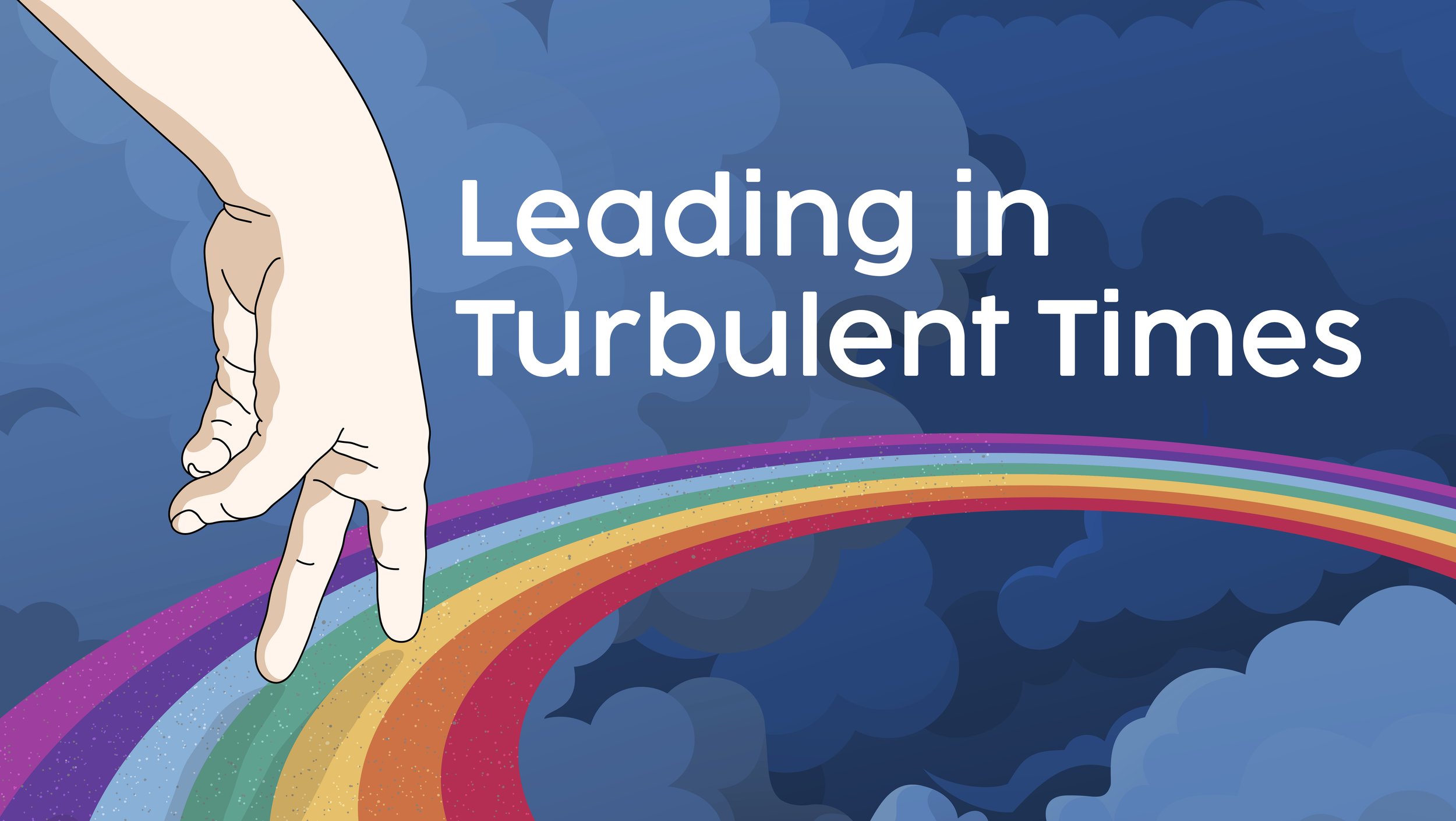LEADING IN TURBULENT TIMES
Greetings Readers. As we near the halfway point of 2023, I can’t help but think about what a wild ride the past few years have been. We’ve experienced a global pandemic, seismic shifts in the global supply-chain and labor market, dynamic political and cultural movements the world over, and rapid technological advances, just to name a few.
Sometimes it feels like we’ve packed a decade of evolution and change into three short years.
In the early days of the pandemic (April 2020), I shared key leadership lessons from the first 30 days of the crisis in China. Reading back now, it’s clear that some of these points are still as pertinent as ever, while others resonate less now that the crisis has ebbed.
What I find most valuable is contemplating the three pillars of leadership I outlined in that post: Leading Your People, Leading Your Organization, and Leading Yourself.
We know it is crucial for leaders to keep their eyes on the horizon, even in turbulent times.
But what should we prioritize in each of these arenas?
Below, I share eight themes that can help steer us all towards success and meaning in the back half of 2023.
I’ve also included recommended readings for each, and I hope they will provide good food for thought for summer reading and reflection.
FOR LEADING YOUR PEOPLE
1. CHECK IN ON WELLBEING
The pandemic marked a shift in how we think about wellbeing in the workplace, and we are all aware that it is more important than ever.
One simple action I am taking is to continue my pandemic practice of the “Wellbeing Check-In”.
Early in the pandemic, I read an article suggesting a helpful action for teams dealing with intense emotions. Begin meetings with a simple, personal question: "How are you?"
I gave it a try, and I was heartened to see the positive effects. Going forward, I will continue this practice. After all, the world has not gotten any less complex or easier to navigate in the past few months.
Maintaining a “Wellbeing Check-In” means that I both make time to ask this question at the start of many group and 1:1 meetings. And, that I create genuine pauses where people can reflect and answer.
I’ve learned the most authentic answers are often shared in person, and I make sure to hold time for personal Q&A sessions in every location I visit. I supplement these with Zoom connects and “office hours,” during which colleagues and team members are encouraged to drop in and chat.
The “Wellbeing Check-In” really is a matter of emphasis. A simple question can create an opening that makes a significant impact.
Recommended Reading:
Should Your Manager Be Responsible for Your Well-being at Work? / via Quartz
The @ Work Guide to Talking With Your Boss / also via Quartz (great for leaders and their teams)
2. EMBRACE NON-LINEAR LEADERSHIP
As we continue to explore the impact of generative AI in the workplace, I encourage leaders to maintain their creative edge by embracing non-linear leadership.
I agree wholeheartedly with this thought from a recent Fast Company piece:
“A creative mind is one designed to look at complex problems and come up with non-linear solutions; solutions that other, more linear thinkers—or alas, AIs— would not necessarily have the mental dexterity to imagine.”
To get started with cultivating your non-linear leadership style, pay attention to how you approach a new challenge with your team.
Non-linear leaders encourage brainstorms. They hold time for divergent thinking, which they may prompt by asking unexpected questions and giving serious time to consider unconventional connections.
How do you know if you are thinking as a non-linear leader would? I’ve been experimenting with a simple test: Is this a question/answer that I could not get from Chat GPT?
I am big a fan of exploring the applications of generative AI to fuel brainstorming. But, at the end of the day, I am making sure to push myself and my team members to make that final (unexpected) turn or connection beyond what AI can generate.
Recommended Reading:
Why Creativity is the Top Skill You Need / via Fast Company
Why Every Boss Should Take An Improv Class / via CNN
3. LEAD WITH AUTHENTICITY
I’ve been thinking a lot recently about how “authenticity” is the foundation of any high-functioning team, especially amidst accelerating change. Those who have worked with me know that I’ve long been a fan of Bill George’s philosophy on this topic.
His timely new book, True North, reminds us that it is all too easy for leaders to lack self-awareness, to let the pursuit of outside rewards hamper our efforts to understand and build our teams from the inside.
His suggested approach is to make sure you can define your “True North,” or your unique moral compass that represents who you are at your deepest level. Once you understand your own internal anchor point, you can turn to understanding those of your co-workers and employees, ultimately creating a team that truly thrives.
This process of True North discernment may sound intimidating, but it really just means making an effort to get to know people through the lens of their values and the things that have shaped them as people.
George’s recent book offers a helpful checklist of questions to jumpstart this process. Any of these would be a great way to start or renew your authentic leadership practice:
“Do I understand my teammate’s career objectives and how their current role helps them develop?”
“Do I understand each person’s intrinsic and extrinsic motivations, as well as their challenges?”
“Do I have deep one-on-one meetings that go beyond superficial discussions?”
“Do we have natural and free-flowing interaction, and are we comfortable with each other, including moments of ‘common humanity?’”
“Do I know my colleagues’ family members and understand their lives outside work?”
I encourage you to dive into the reading below and make authenticity a priority on your team for the months ahead.
Recommended Reading:
True North – Emerging Leader Edition/ summary via Charter
How to Talk To People/ new podcast via The Atlantic
FOR LEADING YOUR ORGANIZATION
4. DEFINE YOUR DIFFERENCE
I recently read a striking article about the “blanding” of culture. In it, Alex Murrell uses compelling visuals and examples to make the case that we live in an age where everything is the same. Across the world, cars, home interiors, coffee shops, book covers, video games, celebrities, architectural styles, social media influencers, and even brands – they all look extraordinarily similar.
Amidst this somewhat uninspiring observation, Murrell highlights an opportunity, one that I see too:
“When every supermarket aisle looks like a sea of sameness, when every category abides by the same conventions, when every industry has converged on its own singular style, bold brands and courageous companies have the chance to chart a different course. To be different, distinctive, and disruptive.”
Job 1 for leaders today is to clearly define what makes your organization unique and to make sure your difference is clear and compelling. Then, to equip and inspire your organization to live that difference at every consumer touchpoint.
Examples of organizations that do a good job standing apart can be difficult to come by, which probably underscores the trend. However, here are a few companies outside of my own that excel at defining their difference:
Patagonia: Continuing to act and innovate with their focus on sustainability and ethical practices.
Warby Parker: Committing to affordable style and a socially conscious business model
Moleskine: Celebrating the power of handwriting as an expression of humanity. I am loving their most recent collaboration with the Van Gogh museum and sponsorship of a traveling collection of artists’ notebooks to amplify their core values.
Recommended Reading:
The Age of Average / by Alex Murrell
5. RETHINK THE DEFINITION OF WORK
It’s no secret that how we work has undergone significant changes over the past few years.
Less understood is that the definition of what work even means is also changing, and leaders must continue helping their organizations adapt.
In this realm, I’ve been inspired by the work and thinking of futurists Jesuthasan & Boudreau, who argue that we need to define a new “Operating System” for work.
In today’s Fourth Industrial Revolution, work is no longer just a series of tasks; it's about playing a role on an agile a team.
Gone are the days when people can be a “supply chain” or “marketing” expert. Rather, I’ve been coaching my team to rethink traditional job descriptions and instead focus on the needed skills and capabilities for the initiative at hand. Then, empowering their talent to flow to what needs to be done.
As we face this changing definition of work, it is important that we as leaders don’t rest on our laurels, thinking our organization has weathered the storm and “figured out” the hybrid workplace.
Rather, we need to have the courage to face the ongoing disruption, living by the mantra that the future of work is not a destination, but a journey.
Recommended Reading:
Work Without Jobs Webinar / via MIT
6. ADOPT AI, STRATEGICALLY
We know that artificial intelligence is transforming the way we work, from automating routine tasks to enabling new levels of personalization and customization.
As organizations continue to hone their AI strategies, I believe the biggest challenge is one of abundance.
When AI is everywhere, it is easy to be lured by red herring applications and use cases that might sound really techy or savvy, but fail to deliver results.
Smart leaders will force themselves to build the right accountability metrics to guide their AI journey.
Of course, every company’s value chain is different. Building an accountability practice will help you understand where in the company AI can add the most value. Then build out those use cases.
On my team at PepsiCo, we are testing different types of tools across the value chain. But with every new pilot, we are working hard to keep ourselves in check, to make sure we are not just chasing the latest tools for tool’s sake.
Recommended Reading:
The Business Case for AI / Kavita Ganesan
Working With AI: Real Stories of Human-Machine Collaboration by Thomas Davenport and Steven Miller
FOR LEADERS THEMSELVES
7. COLORIZE TO OPTIMIZE
Four Thousand. This is the average number of weeks in a human lifespan, a number popularized by former Guardian columnist Oliver Burkeman. Many of the recommendations in this post come back to prioritizing time to do one thing or another. But, how to make sure we’re making the best use of our most scarce resource?
Over the years, I’ve experimented with minding my time by color-coding my entire calendar.
I have several categories, each with a designated color. For example, Running the Business is Green. Long-Term Thinking is Blue. People and Culture is Yellow, and Learning is Red
Then at the end of every month or quarter, I can look at a breakout to understand how I am doing.
Am I spending the right portion of time in each arena? Where do I need to course correct?
I am especially attuned to making time for learning new things, which I believe feeds the critical non-linear leadership mindset I discussed above.
This approach has been a game-changer for me, and I am interested in inspiring and empowering my team members – and their team members – to adopt the bits of it that work for them.
Recommended Reading:
Four Thousand Weeks / Oliver Burkeman
Time Blocking Explainer / via How-To Geek
8. MAKE TIME FOR FUN
If there is one thing the last few years have taught me, it is that sometimes taking a moment to laugh is the best medicine for body and soul.
It turns out science backs me up on this, and I’ve been intrigued by the premise of The Fun Habit. In it, Mike Rucker explains the neuroscience of fun and how it can play a critical role in improving mental and physical health.
This #goodread got me thinking about the fact that humans are designed to live life with hearty doses of levity and enjoyment, yet this can easily get squeezed out as we progress through adulthood and our career trajectories.
The science of “fun” inspires us to think about how we can change the daily cadence of our lives. We need to be as intentional about creating time for “fun” as we are about maximizing our productivity.
I think this is a lens we could do well to infuse into our work culture, and in fact this might just feed right back up to Theme 1 about Protecting Wellbeing.
So, my mid-year resolution will be to schedule more blocks for “fun” into each week; I may even add a color code to my calendar. Who’s with me?
Recommended Reading
The Fun Habit / by Mike Rucker
Why our Best Ideas Come When Having Fun / via Fast Company
So there we have it. Eight themes to guide and inspire the second half of 2023:
FOR LEADING YOUR PEOPLE:
1) Check In on Wellbeing, 2) Embrace Non-Linear Leadership, 3) Lead with Authenticity,
FOR LEADING YOUR ORGANIZATION:
4) Define Your Difference, 5) Rethink the Definition of Work, 6) Adopt AI, Strategically,
FOR LEADERS THEMSELVES:
7) Colorize to Optimize, 8) Make Time For Fun
Thanks for reading. Stay curious, and let’s tackle the balance of 2023 together!
#Leadership #Wellbeing #NonLinearThinking #Authenticity #ChangingWork #AI #TimeManagement #ContinualLearning #Ramalytics



